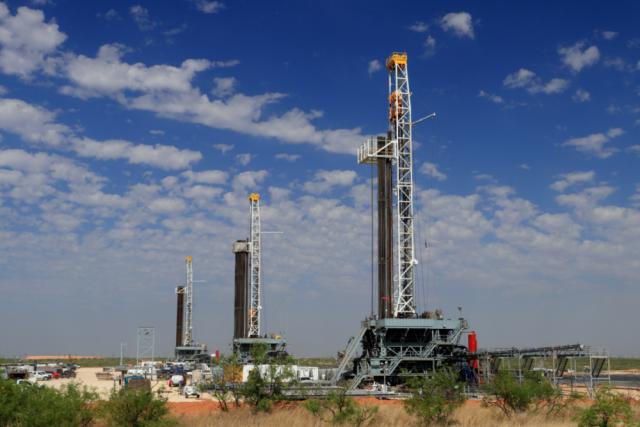
Oil and gas rigs are shown in the Permian Basin. (Source: GB Hart/Shutterstock.com)
Despite some large public independents and supermajors active in major U.S. shale plays taking more measured steps with focus on capital growth and dividends, privates are barreling ahead as oil prices rise. They’re not just in the Permian Basin either, according to Rystad Energy.
Private producers accounted for nearly half of the nation’s horizontal rig count in May, Artem Abramov, head of shale research for Rystad, said on a recent webinar.
“And they’re still adding rigs,” Abramov said. “We are tracking a pretty significant number of smaller private producers, which went completely inactive in 2020, and now more and more such companies are coming back with one, two, sometimes three rigs. This process will continue out in the second half of the year. So, it is actually quite likely that private operators will surpass their public peers in terms of the total number of rigs they run before the end of this year.”
Rystad believes the business model for public independents has changed forever, Abramov said, noting the shift from aggressive production expansion plans to disciplined capital programs with reinvestment rates of 45%-60%.
Analysts are now seeing higher percentages of privates with market share not only in the Permian Basin and the Haynesville, where they respectively make up about 50% and 70%, but also in Appalachia at around 45%. Of the private operators, Rystad data show Endeavor Energy Resources LP, Tap Rock Resources LLC and Nickel Road Operating LLC topped the list of companies with the most approved horizontal drilling permits from January to May, with a combined 351.
The activity is strengthening the U.S. shale sector. Global demand is picking up on vaccination programs that have given major economies confidence in reopening and travel is increasing. Oil prices have climbed above $72/bbl, and OPEC+ is gradually increasing production.
In all, U.S. shale players are increasing drilling though at a slower pace than seen during previous downturns.
“We have already got roughly 200 additional rigs in the U.S. land since the bottom had been reached in Q3 last year. Much of that recovery was observed in the Permian region,” Abramov said.
The rig count in the Permian Basin has essentially doubled, he added. More rigs are also pumping in gas basins and the Eagle Ford, Denver-Julesburg Basin and SCOOP/STACK.
Rystad’s Abramov shared other notables.
Fracking Activity: As of June 16, the number of frac operations in North America has risen back to pre-COVID levels to more than 1,110, up from less than 400 a year ago. “June might become actually the best month this year,” he said.
DUC Inventory: The large inventory of DUCs accumulated in second-quarter 2020 has dropped to a level not seen in the last six or seven years, Abramov added. The total DUC count is less than 5,000, down from more than 6,000 in May, Rystad data show. However, looking at the ratio of DUCs to active rigs, Abramov said the “inventory level still represents a structural anomaly.” In the Permian, for example, Rystad data in late May showed about 6.5 DUCs per rig compared to about 4 DUCs per rig pre-COVID.
Base Decline: The base decline, or pace at which production falls, has improved compared to the beginning of the COVID-related downturn, he said, later noting it is starting to increase again. “In the beginning of 2020, U.S. tight oil production was declining by more than 600,000 barrels a day in the first month without new completions,” Abramov said. “That was almost 200% increase from the base decline level in absolute terms, which we had in late 2016.” Today, it’s trending near 450,000 bbl/d in the first month.
Well Performance: Abramov described well performance nowadays as “robust.”
“On a year-over-year basis, we are still talking about 5%-7% improvement in well performance, driven by a combination of high-grading, shifts toward the most productive locations and a continuous increase in the average lateral length in most regions,” he said.
Maintenance Activity: Improved base decline and better well performance mean fewer wells are needed to keep production flat. “Maintenance activity requirements went down from 900 wells per month in early 2020 to roughly 500-600 wells per month. … But the maintenance activity will also increase as we move into the second half of the year,” Abramov said. “Still, we need to complete just 600 wells per month in H2 2021, and these can be delivered with 320-330 horizontal rigs in major tight oil regions.”
However, if producers want to increase production, the rig count level must rise.
“We see potential for small additions in the second half of the year, with production shifting towards 11.5-11.6 million barrels a day by December 2021,” Abramov said. “As we move into 2022, we see potential for much stronger production recovery as long as oil prices remain at $60 per barrel or higher.”
Recommended Reading
Oceaneering Won $200MM in Manufactured Products Contracts in Q4 2023
2024-02-05 - The revenues from Oceaneering International’s manufactured products contracts range in value from less than $10 million to greater than $100 million.
E&P Highlights: Feb. 5, 2024
2024-02-05 - Here’s a roundup of the latest E&P headlines, including an update on Enauta’s Atlanta Phase 1 project.
CNOOC’s Suizhong 36-1/Luda 5-2 Starts Production Offshore China
2024-02-05 - CNOOC plans 118 development wells in the shallow water project in the Bohai Sea — the largest secondary development and adjustment project offshore China.
TotalEnergies Starts Production at Akpo West Offshore Nigeria
2024-02-07 - Subsea tieback expected to add 14,000 bbl/d of condensate by mid-year, and up to 4 MMcm/d of gas by 2028.
US Drillers Add Oil, Gas Rigs for Third Time in Four Weeks
2024-02-09 - Despite this week's rig increase, Baker Hughes said the total count was still down 138 rigs, or 18%, below this time last year.





